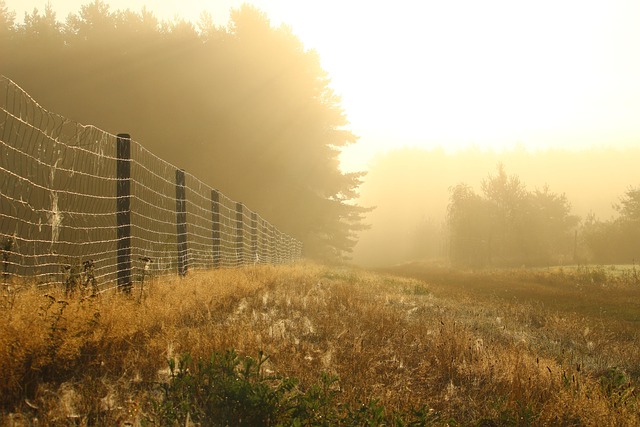Fencing Off Beauty: A Comprehensive Guide to Fence Staining and Sealing
Elevate your outdoor space with a refreshed, protected wooden fence. This guide delves into the art of fence staining and sealing, offering insights that transform your ordinary fence into a stunning centerpiece. From understanding the benefits and exploring various stain types to mastering application techniques and choosing the perfect protective seal, we equip you with the knowledge for a professional finish. Prepare to unlock your fence’s potential and enjoy years of enhanced beauty and durability.
- Understanding Fence Staining: Benefits and Types
- Preparing Your Wooden Fence for Staining
- Choosing the Right Stain: Color and Formula
- Application Techniques for Even Coverage
- Sealing for Protection: Why and How
- Maintenance Tips to Keep Your Fence Looking New
Understanding Fence Staining: Benefits and Types
Fence staining is an essential process for maintaining and enhancing the beauty of wooden fences. It involves applying a colored sealant to protect the wood from elements like sunlight, rain, and UV rays, which can cause fading and cracking over time. The primary benefits include improved aesthetics, extended fence lifespan, and reduced maintenance costs in the long run.
There are several types of fence staining options available. Water-based stains offer easy application and faster drying times, making them ideal for quick projects. Oil-based stains penetrate deeper into the wood, providing superior protection but requiring more time for curing. Semi-transparent stains allow some grain visibility while offering moderate protection, while solid color stains completely obscure the natural wood look, perfect for those seeking a dramatic transformation.
Preparing Your Wooden Fence for Staining
Before applying any stain or sealer, it’s crucial to prepare your wooden fence thoroughly. Start by power washing the fence to remove any built-up dirt, mold, or mildew. This step ensures that the surface is clean and free from contaminants, allowing for better adhesion of the stain. After washing, dry the fence completely to prevent water spots from affecting the staining process.
Next, inspect the wood for any damaged areas such as rotten boards, splinters, or cracks. Repair these issues using appropriate wood patching compounds or replace faulty sections as needed. Sanding the fence gently can also help smooth out rough surfaces and create a more even base for staining. This preparation work is essential to achieving a professional finish and extending the lifespan of your fence’s protective coating.
Choosing the Right Stain: Color and Formula
When it comes to fence staining, selecting the perfect color is just the first step. It’s equally important to choose a stain formula that suits your wooden fence’s needs. Water-based stains are popular for their ease of application and fast drying time, making them ideal for areas with high humidity or frequent rainfall. They also offer a more environmentally friendly option due to lower volatile organic compound (VOC) levels. Oil-based stains, on the other hand, provide deeper colors and better protection against fading, UV rays, and severe weather conditions. These stains penetrate the wood, enhancing its natural grain while offering longer-lasting results, but they can be more challenging to apply and have a stronger odor.
Consider your fence’s location, exposure to elements, and desired maintenance level when making your selection. For fences in shaded areas or those that don’t see much direct sunlight, lighter colors may work best to prevent the wood from appearing washed out. Conversely, sunny locations might benefit from darker shades that can better withstand the sun’s damaging rays. Remember, different stain manufacturers offer various color ranges and formulas, so taking samples home to test on your fence before committing to a full project is always recommended.
Application Techniques for Even Coverage
When applying stain or sealant to a wooden fence, even coverage is essential to achieve a uniform and aesthetically pleasing finish. Start by ensuring your fence is clean and free from any debris, dust, or dirt. Use a pressure washer or a brush with mild detergent to thoroughly clean the wood. This step removes impurities that could prevent the product from adhering properly.
For even coverage, use a broad-bristled brush or a roller applicator. Broad strokes in the direction of the grain will help distribute the stain or sealant evenly. Ensure you apply an even coat, avoiding overspray onto surrounding surfaces. If using a roller, consider using a 1/4-inch nap to achieve smooth, consistent coverage without leaving marks or streaks.
Sealing for Protection: Why and How
Sealing is an essential step in fence staining and maintenance, offering a protective layer against the elements. Wood, being porous, can absorb moisture, leading to rot, warping, and fading over time. Sealer acts as a barrier, preventing water penetration and sealing in the original color of your fence. This is particularly crucial for outdoor fences exposed to varying weather conditions.
The process involves applying a coat (or multiple coats) of sealant specifically designed for wood. These sealers can be water-based or oil-based, each with its advantages. Water-based sealers are easier to apply and emit fewer fumes, while oil-based options offer better protection against UV rays and extreme temperatures. Regular sealing every 1-2 years will ensure your wooden fence remains in top condition, preserving its aesthetic appeal and structural integrity.
Maintenance Tips to Keep Your Fence Looking New
Regular maintenance is key to keeping your wooden fence looking new and vibrant. Start by cleaning the fence at least twice a year using a soft brush or cloth to remove any dirt, dust, or debris that may have accumulated. Avoid harsh chemicals as they can strip away the protective coating. After cleaning, inspect the fence for any signs of damage, rot, or peeling stain. Repair or replace damaged sections immediately to prevent further issues.
Apply a fresh coat of sealant every 1-3 years, depending on exposure to weather conditions and traffic. This will create a protective barrier against water, UV rays, and environmental pollutants. Keep the area around the fence clean and free from plant growth to ensure even coverage and prolonged protection.
